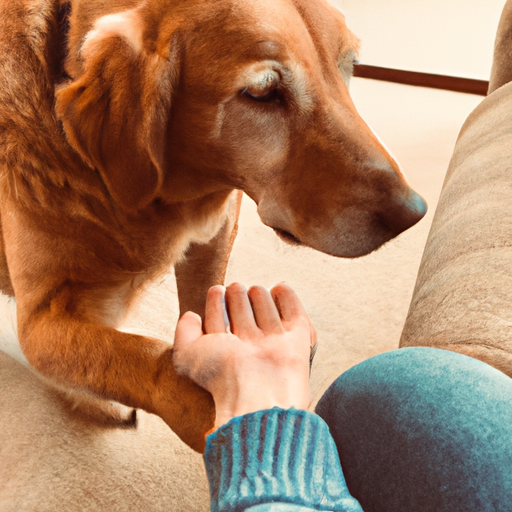1. A Gesture of Affection
Often, when your furry friend places their paw on you, it’s their way of expressing love and camaraderie. Dogs, much like humans, enjoy physical contact and often use it to express their affection. So, when your dog puts their paw on you, they might just be saying, “I love you.”
- They may do this while you’re sitting on the couch, watching TV or even when you’re giving them a belly rub. It’s their way of reciprocating the affection you’re showing them.
- It’s crucial, however, to pay attention to other signals your dog might be giving off. Along with the pawing, if they’re wagging their tail and have a relaxed posture, it’s a good sign they’re comfortable and happy.
2. Seeking Attention or Comfort
Just like a child tugging at your sleeve, dogs use pawing as a means to grab your attention. Your dog might place their paw on you when they’re feeling anxious or when they’re seeking comfort.
- If they’re anxious, they might also display other signs like whining or pacing around.
- If they’re seeking comfort, they might cuddle up close to you and rest their head in your lap, along with the pawing.
3. A Sign of Dominance
Contrary to the previous points, sometimes, dogs paw at their owners to assert dominance.
| Dominance Indicators | |
|---|---|
| Pawing | ✔️ |
| Growling | ✔️ |
| Aggressive Posture | ✔️ |
If your dog is showing these signs, it might be time to consult with a professional dog trainer or behaviorist.
4. They Want to Play
Dogs are playful creatures. Sometimes, a paw on you is simply an invitation to play. If they accompany the pawing with playful barks, or if they bring their favorite toy to you, it’s a pretty clear sign they’re in the mood for some fun.
5. Training or Habit
Sometimes, dogs paw at their owners because they’ve been trained to do so, or it’s become a habit.
- If you’ve rewarded your dog in the past for pawing (with treats, attention, etc.), they’re likely to repeat the behavior.
- Similarly, if your dog has gotten into the habit of pawing, they might do it subconsciously, just like we might bite our nails or twirl our hair without realizing it.
Frequently Asked Questions
Q1: Is pawing a sign of aggression in dogs?
A1: Not always. Pawing can be a sign of affection, attention-seeking, or playfulness. It’s only when it’s accompanied by other signs of aggression like growling or an aggressive posture that it might be a cause for concern.
Q2: How can I discourage my dog from pawing?
A2: Ignore the pawing behavior and reward your dog when they’re calm and not pawing. If necessary, consult with a professional dog trainer.
Q3: Can pawing be a sign of illness in dogs?
A3: Sometimes. If your dog is pawing at themselves excessively, or if they seem to be in pain when they paw, it’s best to consult with a vet.



